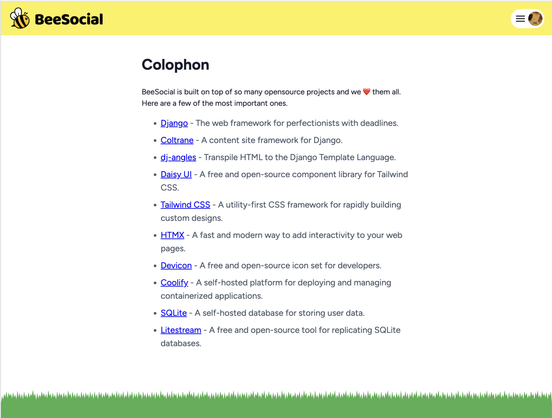Ever wonder about the accessibility of htmx UIs? We have too 👉️ https://wagtail.org/blog/htmx-accessibility-gaps-data-and-recommendations/ Includes a review of the available data, common gotchas, and recommendations to navigate those challenges, with a particular focus on the #django ecosystem
#Htmx
htmx v2.0.5 released
Colophon for https://beesocial.dev for anyone interested: https://beesocial.dev/colophon.
No vibe coding, just good vibes.
#Datastar #Hypermedia Framework - combining #HTMX + #AlpineJS functionality!
> There is a better way. And it doesn’t require a complete rewrite of the internet or a return to 2005.
The way’s #HTMX – server-side rendering, clean accessible html, but with interactive controls unavailable in 2005 (or even today in pure html). But no complex “frontend-side logic”.
Ils sont sympas chez htmx, ils vous expliquent même comment vous passer d'htmx tout en réalisant des applications qui correspondent à ce qu'htmx permet. Et il y a quelques pépites là-dedans ! https://htmx.org/essays/alternatives/ #htmx #alternatives #web #html
I got a really helpful question on HN about #HyperTemplates vs #HTMX that nerd-sniped me into a long answer:
🔍 Dopo anni di sviluppo web “moderno” ho riscoperto le basi: HTML, REST (quello vero!) e un modo diverso di pensare le web app.
📅 Il 19 giugno sarò al Delphi Day 2025 a Piacenza con un seminario sulle Hypermedia‑Driven Applications con HTMX + Delphi.
Parleremo di:
✅ HDA e architettura ipermediale
✅ HTMX, REST e API davvero RESTful
✅ Pro e contro rispetto alle SPA
Tutte le info e i biglietti qui:
🎟️ https://www.delphiday.it
Vi aspetto! 🤗
Introducing the Django-Spellbook Editor:
https://django-spellbook.org/editor/
I've been working on this project for the last week, I want to integrate it into a /sb-admin url similar to how #wagtail does it, but as a much simpler lightweight markdown parser.
Right now it's only available on the docs website for testing purposes :) please try it out, I hope you like it!
It's made through #HTMX and vanilla JS , so would it be too much of a hassle to require people use HTMX to use this library's admin editor? I guess I have to explore Wagtail's code and see how they did it; https://github.com/wagtail/wagtail
#HTMX is growing on me.
It felt weird at first to generate frontend from the backend. But I gave in because writing more code at the backend was way too tempting. I just can't hold #javascript right.
Using templates and SQL, creating frontend using #php and htmx is pretty nice. Kind of feel like doing #graphql and #Rest together.
But at the end of the day, I am writing less javascript and it is great.
Just added #HTMX to a #Django project. Performing a lazy loading of one part of a dashboard and allowing to change the period of it (month/year) without reloading the entire screen. It was simpler than I expected. Still need to add some error handling (I saw few examples of it!) and probably I'm organizing the template in a way that won't scale in a bigger project, but it is a good start!
A los que hacen web apps con Python, no se si conociais Unicorn.
https://www.django-unicorn.com/
Es un framework que automatiza los procesos similares a lo que puedes lograr con HTMX: enviar eventos por AJAX al backend y que este te devuelva HTML que será insertado/remplazado.
#django #python #htmx
@adamghill I find Unicorn's case very interesting. On a technical level, it's a clear evolution of HTML. It automates processes, eliminates the need to maintain an API, has very good integration with the backend, and has a very clear focus on the developer experience. However, in terms of popularity, it hasn't had the same impact... but I don't think Unicorn is to blame.
My experience, after trying to extend the idea of HTML over Websockets, is that for software to be successful in the developer community, it must be easy to use, understand, integrate with other systems, and read its documentation. HTML ticks all the boxes. You can quickly install and use it, we all understand that it's an HTTP call, and I can use it alongside other frameworks and backends without incompatibilities. Furthermore, the documentation is minimalist; you can read it from top to bottom in 5 minutes. Unicorn, on the other hand, requires a bit more effort to understand how it works, how it integrates with other systems, and how to maintain it. Not because it's a poorly done technology, but because it's more complex with a different approach. So, if we draw a line between a "good" technology that requires work to understand, and a "simple" technology with poor results but is easy to use, HTMX falls somewhere in the middle. Unicorn would be slightly closer to the beginning.
I suppose a niche of experienced seniors using Unicorn is emerging, and on the other hand, a mainstream technology with the HTMX approach. And that's not a bad thing; it's just how the market works.
#unicorn #htmx #django #python
Have you heard of fixi? https://github.com/bigskysoftware/fixi
HTMX with injee
Why not only htmx for a web site...because..
https://www.synthetic-depo.com/
Discussions: https://discu.eu/q/https://www.synthetic-depo.com/

